Annelids are largish worms, easily visible to the naked eye, they are the worms we think of when considering the morning habits of the early bird. They often appear quite similar unless you are another worm, they may be free or tube living and have a range of feeding strategies. Earthworms help shape the very landscape and improve agricultural land.
Annelidia - Annelids - Segmented Worms
Annellus - "little ring"
Earthworms are the best known Annelids, diligently going about their quiet business turning the soil over, helping to recycle dead leaves and other vegetation, improving the texture and nutrient content of the soil. There are many other types though including leeches and many aquatic and marine species that may be active hunters, filter feeders and may be surprisingly active swimmers. Their defining characteristic is their segmentation, they are made of a large number of repeated body sections each of which is more or less identical.
Typical Annelids
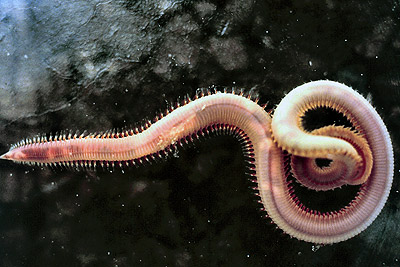
A polychaete bloodworm, Glycera
sp.
The paddles used for swimming can
be seen clearly in this picture. Such bloodworms have
the red respiratory pigment, haemoglobin, which allows
them to get oxygen from oxygen poor environments such
as mud.
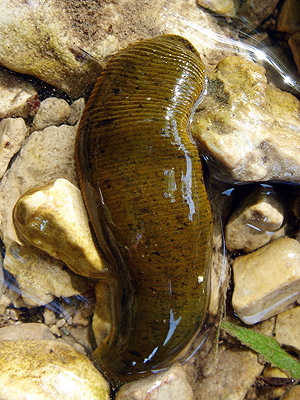
A leech in a freshwater stream
Leeches are blood suckers or predators of smaller invertebrates,
they can bite without it being felt and use anti-coagulants
to allow the blood to flow freely.
picture Chris Schuster - CC2
Attribution ShareAlike 2.0 License
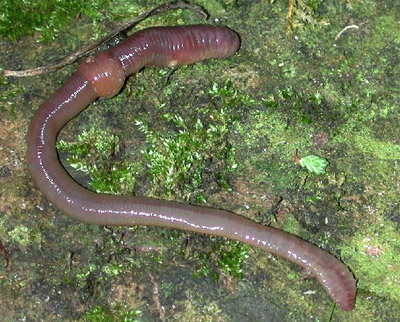
Earthworm, Lumbricus sp.
The top end is the front, note that this is
rounded while the tail end is noticeably flattened.
The pale ring about 1/5 of the way along is the "clitellum",
this is involved in reproduction and egg case formation.
picture Michael Linnenbach
- GNU Free Documentation
License, Version 1.2
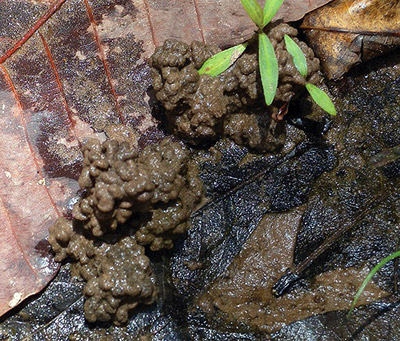
Earthworms casts
The basic material
of many rich soils around the world. Earthworms swallow
the finer parts of the soil in order to absorb the bacteria
and other micro-organisms contained, they then void
the waste. In this way, they sort out the finer parts
of the soil and bring them to the surface. They also
draw down dead leaves and other plant material and help
to incorporate them into the soil and cause stones to
sink into the soil.
picture Chanabun R, Sutcharit
C, Tongkerd P, Panha S - CC3 Attribution Unported licence
Cool Annelids
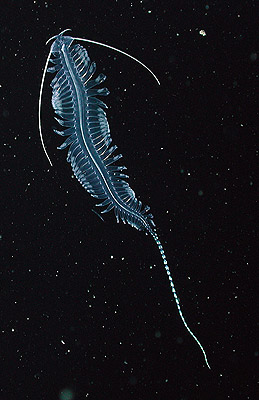
Tomopterid worm - Family
Tomopteridae
Swimming above Davidson
Seamount at 389 meters water depth.
picture courtesy NOAA

A tube dwelling polychaete worm
- Feather duster worm Sabellastarte sp.
The feathery structures are called radioles
that are used to filter feed in the water, most of the
worm is inside a protective tube that is very hard (calcified),
the radioles can be very quickly brought into the tube
if danger threatens.
picture
courtesy NOAA
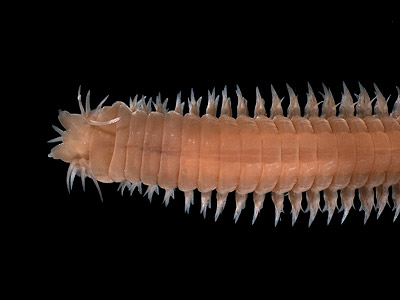
Marine polychaete worm
A predatory annelid, the "paddles" on each segment allow
for swimming or crawling over rocks and corals.
picture - Hans Hillewaert
used under CC4 Attribution-Share Alike International
license
Kingdom - Animalia
Phylum - Annelidia
Basic Features:
- Vermiform (worm-like!)
- Externally segmented which is reflected
on the inside, internal segments separated
by septa (walls) with identical copies of muscles,
nerves and excretory structures.
This division of the body into similar repeating segments is known as "metamerism" or "metameric segmentation" - Each segment has 2 pairs of setae or hairs made of chitin, these are used for locomotion and may be developed into paddle-like appendages in aquatic forms
- Hydrostatic (liquid) skeleton comprises of body fluid that is contained within a segment
- Segments have longitudinal and circular muscles that work antagonistically (against each other) in locomotion
- Have blood, a simple circulatory system, blood vessels with valves and a heart.
- Reproduction is sexual, many species are hermaphrodite (both male and female at the same time)
- Members of the group may be land dwelling, in soil or sediments or aquatic
- Some members show a high degree of encephalization (development of a head)
- Size from 1mm to up to 3m - typically in the region of 1-20cm
What do annelids eat?
Some annelids are hunters, the prey usually being other small invertebrates. Some are completely free living, other are tube dwellers and emerge from the tube to grab suitable prey with their jaws as they pass by. Many leeches catch their food in this manner too, often swallowing them whole, even if quite large.
Many annelids are detritivores feeding on sediments and deposits for what they contain in terms of smaller invertebrates and micro-organisms. Many tube-dwelling marine worms are like this, they can be seen at low tide on sand or mud flats, typically there is a depression in the substrate and then 20-40cm away a pile of extruded mud or sand that has been processed. Ragworms much used by fishermen as bait feed in this manner as do terrestrial earthworms which exist almost wherever there is soil.
There are many such as the feather-duster worms that are filter feeders, using radioles protruded from their burrows to capture small planktonic organisms in the water to bring to the mouth. Other filter feeders may live in tube and siphon water through one entrance and out again through a second in a similar manner to the rag worms above.
Some leeches such as the well known medicinal leech are blood feeders on vertebrates, though relatively few of the group. They secrete an anti-coagulant called "hirudin" which stops blood from the wound clotting and makes it easier for the leech to feed. It also means that wounds made by these leeches may bleed profusely for several hours after the leech has had its fill and has dropped off. Medicinal leeches may only need to feed once or twice a year.
What eats annelids?
Annelids make a good easy to digest protein-rich meal for many other animals. The lack of a hard skeleton makes them easy to swallow. They are a major part of the diet for many fish and for many land animals such as moles, hedgehogs and birds such as the black bird.
How common are Annelids?
Annelids are often almost invisible in a habitat as they tend to be burrowing animals when present in largest numbers.
Estimates from marine habitats such as Tampa Bay Florida where they burrow in the sediment are as high as 13,425 individuals per square metre.
A typical farmers field in the temperate regions has about 1million earthworms per acre, they quietly and silently plough the earth slowly and relentlessly over the years. They slowly but surely bury anything on the surface and are responsible for the layer of soil that enables plants to grow. Charles Darwin thought they were one of the most important organisms on the earth, they are in no small part responsible for the gentle rolling landscape of England where he studied them.
Locomotion in
Annelids
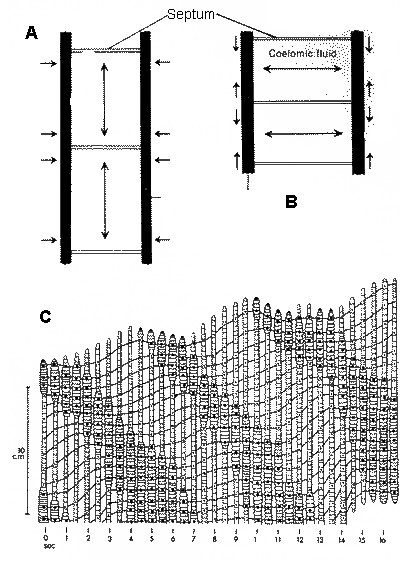
The hydrostatic (contained water) skeleton of annelids
is held within the segments as in A and B above. The
segments are separated by the structures labelled 'septum",
there are longitudinal muscles as in "A" which act against
the contained liquid (the coelomic fluid), these contract
and shorten the segments to go to the state in "B".
At this point circular muscles contract and act against
the fluid to go back to "A". A co-ordinated contraction
of these two sets of muscles cause the worm to move
forwards as in C.
The group includes:
- Earthworms, many different species found almost everywhere there is soil.
- Polychaetes, mostly marine species, often with extended setae that form paddles of some kind for swimming. Often very brightly coloured, can be red, pink or green or some combination. May be free-living, burrow dwelling or make a hard calcified tube on rocks, ships hulls, wooden structures or flotsam or on the shells of other animals.
- Hirudinea, the leeches, best known for their parasitic bloodsucking habits but most feed on small invertebrates including earthworms which they swallow whole.
Giant Earthworm
Cinnamon worm emerging from a tube - reef dwelling
filter feeder
Banner picture at top of page - Fan worm, Bispira brunnea, courtesy James St. John, used under CC2 Attribution Generic licence.
